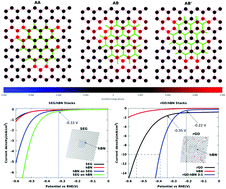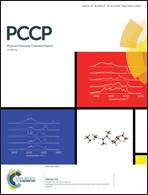On the hydrogen evolution reaction activity of graphene–hBN van der Waals heterostructures†
Abstract
Although graphene technology has reached technology readiness level 9 and hydrogen fuel has been identified as a viable futuristic energy resource, pristine atomic layers such as graphene are found to be inactive towards the hydrogen evolution reaction (HER). Enhancing the intrinsic catalytic activity of a material and increasing its number of active sites by nanostructuring are two strategies in novel catalyst development. Here, electrocatalytically inert graphene (G) and hexagonal boron nitride (hBN) are made active for the HER by forming van der Waals (vdW) heterostructures via vertical stacking. The HER studies are conducted using defect free shear exfoliated graphite and hBN modified glassy carbon electrodes via layer by layer sequential stacking. The G/hBN stacking pattern (AA, AB, and AB′) and stacking sequence (G/hBN or hBN/G) have been found to play important roles in the HER activity. Enhancement in the intrinsic activity of graphene by the formation of G/hBN vdW stacks has been further confirmed with thermally reduced graphene oxide and hBN based structures. Tunability in the HER performance of the G/hBN vdW stack is also confirmed via a three-dimensional rGO/hBN electrode. HER active sites in the G/hBN vdW structures are then mapped using density functional theory calculations, and an atomistic interpretation has been identified.



 Please wait while we load your content...
Please wait while we load your content...